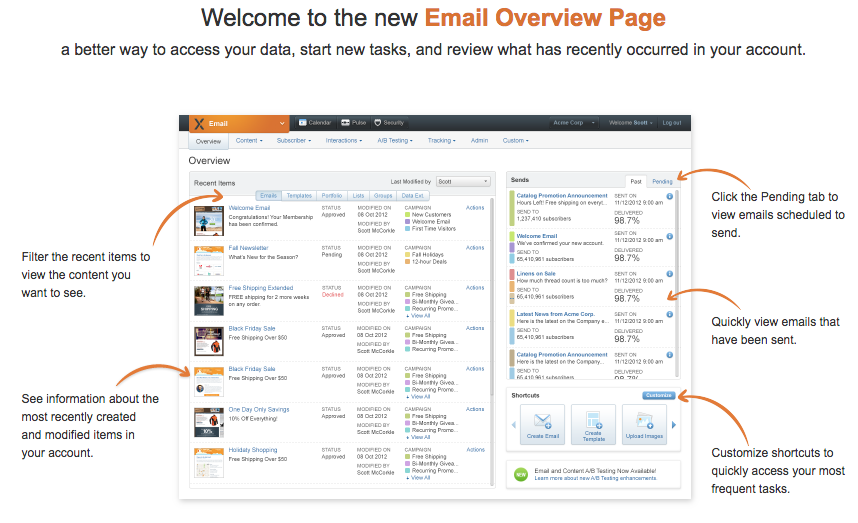Best practices in general
Subject Line Best Practices
Subject lines are the first thing a subscriber reads. If it doesn’t grab their attention, the work you put into the email is lost. How can you ensure your subject lines are effective?
Keep them short and sweet. Short and medium-length subject lines have higher open rates than long ones, which ultimately affects conversion rates (the percentage of people who take action based on your email). What’s more, Internet service providers sometimes truncate subject lines. So limit them to 50 characters or fewer.
Of course, limiting the length of your subject line doesn’t mean you have to sacrifice style. Infuse your brand into the messaging and take advantage of brand loyalty. Catch the reader’s eye with symbols, creative wordplay, or by building intrigue.
Then test, test, and test again! This is how you determine which subject lines yield the best results. With good email marketing services (like Salesforce Marketing Cloud Email Studio) it’s easy as A, B, C. Actually, it’s as easy as A/B Testing.
Subject line best practices
| Subject Line | Why It Works |
|---|---|
| Hold your breath until you see this | This subject line for an air freshener product builds intrigue and relates to the product being promoted. |
| Dads: This email is not for you. Forward to your family. | A forwarding request makes you want to read the email. So does being told it’s not for you. |
| Starfish. You named it. You bought every pair. And we made more. | Making recipients feel as if they are missing out encourages them to want to be in the know! |
| Express shipping: on Dasher, on Dancer, on Procrastinator | Addressing someone or identifying with someone makes them feel understood and like they are being spoken to on a personal level. In this example, we’re addressing that sometimes “we” procrastinate when it comes to holiday shopping. |
Less successful subject lines
| Subject Line | Why It Fails |
|---|---|
| [Day of Week] Newsletter | This says nothing except which day of the week it is. |
| RE: Previous email | This is misleading. Putting a RE: message in the subject line could cause subscribers to be annoyed and unsubscribe or report you as spam. |
| [Blank]: Check out this deal. | Make sure you have a default value such as “Valued Customer” in place of a first name, for example, to avoid having a blank in the subject line. |
A Call to Action
Personalization and relevance are great. But generally, the purpose of marketing emails is to prompt your subscribers to do something. For this you need a good call to action (CTA). This can be a limited-time offer, or a prompt to enter a contest, visit a website, or sign up for an event. Give your customers an irresistible reason to open your email, and once opened, take action.
Not all CTAs are created equal—great CTAs are:
- Urgent: Use CTAs that create a need for urgent action.
- Brief: State the CTA briefly, with no more than five words.
- Action-oriented: Begin your CTA with a verb (download, register, buy, save).
- Clear and predictable: Be clear and link to a place that doesn’t surprise subscribers.
- Limited and visible: Focus subscribers’ attention on one to two prominent CTAs.
Manage Email Frequency
Another best practice is to deliver what you promise. If you promised a monthly newsletter, make sure you send it monthly. Not bimonthly, not every other week—monthly. Not only do you want your communications with your subscribers to be personal and relevant, you want them to be anticipated
Bounce and Purge
When you send out marketing emails, you often receive bounce-back messages alerting you to defunct email accounts. It‘s critical that you remove any bounced addresses from your mailing lists between one marketing message and the next that you send. Even though most email marketing systems stop sending to addresses that bounced a set number of times, a bounce rate over 20% for any single mailing can have serious consequences. This is because if deliverability is bad, your IP address can be put on a blacklist.
We also recommend purging old or inactive addresses from your mailing lists. Don’t keep those names and emails that you haven’t emailed in months. Don’t spend money on sending emails that aren’t even being opened.
Best practices for Salesforce
 Roles: https://members.s7.exacttarget.com/Content/Administration/Roles/RoleDetails.aspx?id=26dfc03f-a279-e411-b14e-38eaa731a765
Roles: https://members.s7.exacttarget.com/Content/Administration/Roles/RoleDetails.aspx?id=26dfc03f-a279-e411-b14e-38eaa731a765

